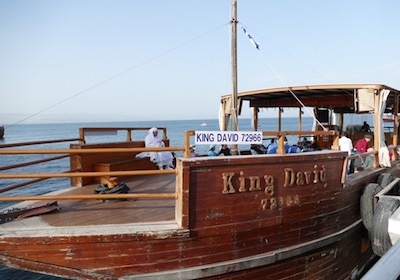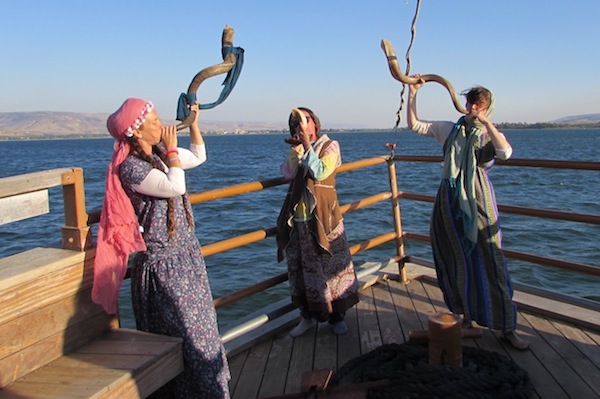Left to right: Devorah Abramson, Yehudit Dribben and Sheva Chaya blow the shofar at Miriam’s Well on Lake Kinneret. (photo by Aviva Spiegel)
In the annals of the current COVID-19 pandemic, artist Maureen Kushner has a rare happy story – and likely the only one dating back some 3,500 years.
For the last 12 years on the anniversary of the death of Miriam the Prophetess on Nissan 10 in the Hebrew calendar, New York-born Kushner has been chartering a vessel from Tiberias-based Holyland Sailing Ltd. to bring a boat full of women to the spot on Lake Kinneret where, according to Midrash (Bamidbar Rabbah 1:1), the mystical spring known as Miriam’s Well now rests.
Typically, 126 women and children (corresponding to Miriam’s age when she died) equipped with rams horns, violins, harps, drums, flutes, guitars and tambourines have made the maritime pilgrimage. They sail on the Sea of Galilee, also called Lake of Gennesaret, to what Jewish tradition considers the exact spot where the miraculous spring that supplied the Children of Israel with drinking water during their 40 years of wandering in the Sinai Desert ended its own journey.
This year, the yahrzeit (death anniversary) of Miriam fell on Friday, April 3, immediately before Passover. Kushner – who is named in Hebrew after the miracle-working older sister of Moses and Aaron – booked the sailing for Thursday, April 2, in order to allow Sabbath-observant women from Jerusalem and other distant cities to join in the fête. All was set for this year’s celebration when Israel’s Health Ministry locked the country down in an attempt to halt the spread of the coronavirus.

Thanks to those regulations, which at their most severe restricted Israelis to remaining within 100 metres of their home and still prevent almost all non-citizens from landing at Ben-Gurion Airport, the pandemic has somewhat abated. Recently, the Health Ministry began lifting its pandemic regulations.
Without any tourists arriving, the pilgrim boats remained moored in Tiberias and at Kibbutz Ginosar for three months. But, on Wednesday, June 3, the ministry allowed Kushner and her social distancing-reduced group of 40 women and children – each bringing facemasks, water, hats, sunscreen and kosher snacks – to make their 135-minute voyage on the lyre-shaped lake. When the vessel King David raised its anchor, it was Holyland Sailing’s first boat trip since quarantine regulations went into effect.
“What a hallelujah for our beloved Kinneret!” said Kushner, who was the artist-in-residence at the Jewish Community Centre of Greater Vancouver in 2005. “What a hallelujah in honour of our great, great, great Hakodesh Baruch Hu [the Holy One Blessed Be He], who is filled with goodness and compassion and love and blesses Am Yisrael [the Jewish people] with rain and dew and sustenance and a good life here in Eretz Israel, the good land.”
Kushner was especially excited that this past winter has seen heavy rains that filled Israel’s main freshwater reservoir to the brim, at 209 metres below sea level after five years of drought.
“The Kinneret is full! In great and abundant thanks to Hashem [God] in the zechut [merit] of Miriam Hanivia [Miriam the Prophetess], we celebrated with shofarim, drums, flutes and the harp,” she said.
Miriam the Prophetess today has become a popular figure for many Jewish women.
The Torah relates she was married to Caleb ben Yefunah. Though she died in the wilderness of Zin, her widower miraculously carried the spring named in his wife’s honour across the Jordan River on Nissan 10, the anniversary of her death, explained Kushner.
Miriam’s death is described in Numbers 20:1 and, in the next verse, the Israelites are described as complaining of the lack of water at Kadesh. The text reads, “Miriam died there, and was buried there. And there was no water for the congregation.”
In Jewish texts, this abrupt transition between her death and the lack of water was explained by postulating that a “Well of Miriam” appeared after she died. Further elaboration identified the rock that Moses struck to bring forth water in Exodus 17:5-6 with this well.
So powerful was the tradition of Miriam’s Well in Judaism that, even after the spring disappeared into Lake Kinneret some three-and-a-half millennia ago, it has occasionally miraculously appeared in the Diaspora.
According to Chassidic lore, once, just before Yom Kippur’s Kol Nidre prayer began, Yitzchak Isaac Taub (1751-1821), who was the sage of Nagykálló (Kalov in Yiddish) in eastern Hungary, called on his assistant Rabbi Yaacov Fish to harness his horse and wagon. The two set out to Fish’s fields, where they found a small pool. Immediately, the holy man disrobed and immersed himself, while Fish stood by transfixed. After the Day of Atonement, Fish returned to his fields, but the pond had disappeared. Fish asked his master, “Rabbi, as you know, despite our long friendship, I never mix into your affairs. But I beg you to enlighten me about the pool of water that appeared and disappeared so mysteriously in my fields.”
The holy man, who founded the Kaliver Chassidic dynasty, smiled: “If Rabbi Yaacov had had the sense, he would have dipped himself the same as I did, for, at that moment, Miriam’s Well passed by.”
Gil Zohar is a writer and tour guide in Jerusalem.
(Note: This article has been updated from the print version to note that Maureen Kushner was the artist-in-residence at the Jewish Community Centre of Greater Vancouver in 2005.)

